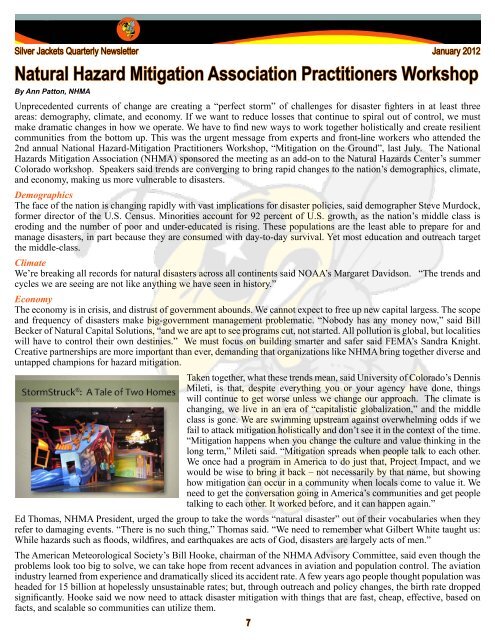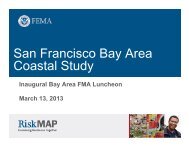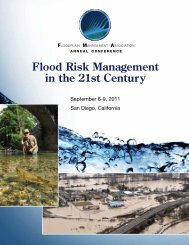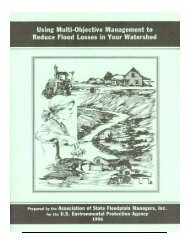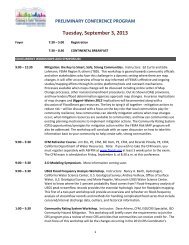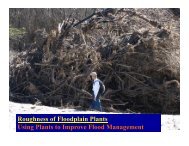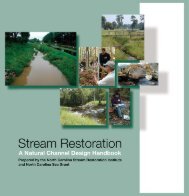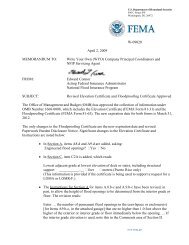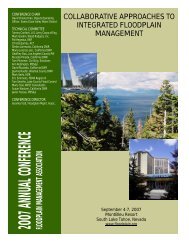Silver Jackets Quarterly Newsletter, January 2012 - Floodplain ...
Silver Jackets Quarterly Newsletter, January 2012 - Floodplain ...
Silver Jackets Quarterly Newsletter, January 2012 - Floodplain ...
You also want an ePaper? Increase the reach of your titles
YUMPU automatically turns print PDFs into web optimized ePapers that Google loves.
<strong>Silver</strong> <strong>Jackets</strong> <strong>Quarterly</strong> <strong>Newsletter</strong><br />
7<br />
<strong>January</strong> <strong>2012</strong><br />
Natural Hazard Mitigation Association Practitioners Workshop<br />
By Ann Patton, NHMA<br />
Unprecedented currents of change are creating a “perfect storm” of challenges for disaster fighters in at least three<br />
areas: demography, climate, and economy. If we want to reduce losses that continue to spiral out of control, we must<br />
make dramatic changes in how we operate. We have to find new ways to work together holistically and create resilient<br />
communities from the bottom up. This was the urgent message from experts and front-line workers who attended the<br />
2nd annual National Hazard-Mitigation Practitioners Workshop, “Mitigation on the Ground”, last July. The National<br />
Hazards Mitigation Association (NHMA) sponsored the meeting as an add-on to the Natural Hazards Center’s summer<br />
Colorado workshop. Speakers said trends are converging to bring rapid changes to the nation’s demographics, climate,<br />
and economy, making us more vulnerable to disasters.<br />
Demographics<br />
The face of the nation is changing rapidly with vast implications for disaster policies, said demographer Steve Murdock,<br />
former director of the U.S. Census. Minorities account for 92 percent of U.S. growth, as the nation’s middle class is<br />
eroding and the number of poor and under-educated is rising. These populations are the least able to prepare for and<br />
manage disasters, in part because they are consumed with day-to-day survival. Yet most education and outreach target<br />
the middle-class.<br />
Climate<br />
We’re breaking all records for natural disasters across all continents said NOAA’s Margaret Davidson. “The trends and<br />
cycles we are seeing are not like anything we have seen in history.”<br />
Economy<br />
The economy is in crisis, and distrust of government abounds. We cannot expect to free up new capital largess. The scope<br />
and frequency of disasters make big-government management problematic. “Nobody has any money now,” said Bill<br />
Becker of Natural Capital Solutions, “and we are apt to see programs cut, not started. All pollution is global, but localities<br />
will have to control their own destinies.” We must focus on building smarter and safer said FEMA’s Sandra Knight.<br />
Creative partnerships are more important than ever, demanding that organizations like NHMA bring together diverse and<br />
untapped champions for hazard mitigation.<br />
Taken together, what these trends mean, said University of Colorado’s Dennis<br />
Mileti, is that, despite everything you or your agency have done, things<br />
will continue to get worse unless we change our approach. The climate is<br />
changing, we live in an era of “capitalistic globalization,” and the middle<br />
class is gone. We are swimming upstream against overwhelming odds if we<br />
fail to attack mitigation holistically and don’t see it in the context of the time.<br />
“Mitigation happens when you change the culture and value thinking in the<br />
long term,” Mileti said. “Mitigation spreads when people talk to each other.<br />
We once had a program in America to do just that, Project Impact, and we<br />
would be wise to bring it back – not necessarily by that name, but showing<br />
how mitigation can occur in a community when locals come to value it. We<br />
need to get the conversation going in America’s communities and get people<br />
talking to each other. It worked before, and it can happen again.”<br />
Ed Thomas, NHMA President, urged the group to take the words “natural disaster” out of their vocabularies when they<br />
refer to damaging events. “There is no such thing,” Thomas said. “We need to remember what Gilbert White taught us:<br />
While hazards such as floods, wildfires, and earthquakes are acts of God, disasters are largely acts of men.”<br />
The American Meteorological Society’s Bill Hooke, chairman of the NHMA Advisory Committee, said even though the<br />
problems look too big to solve, we can take hope from recent advances in aviation and population control. The aviation<br />
industry learned from experience and dramatically sliced its accident rate. A few years ago people thought population was<br />
headed for 15 billion at hopelessly unsustainable rates; but, through outreach and policy changes, the birth rate dropped<br />
significantly. Hooke said we now need to attack disaster mitigation with things that are fast, cheap, effective, based on<br />
facts, and scalable so communities can utilize them.


